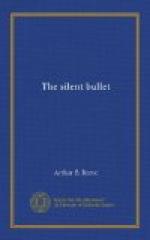“Excuse me, Commissioner, if I interrupt, but I think we have carried this part of the programme far enough to be absolutely convincing,” said Craig. “Thank you very much for the clear way in which you have put it.”
Craig snapped the announcer, and a letter appeared on the screen. He said nothing, but let us read it through.
To whom it may concern:
This is to certify that Bridget Fallon has been employed in my family at Shelter Island for the past season and that I have found her a reliable servant and an excellent cook.
A. St. John Caswell-Jones.
“Before God, Mr. Kennedy, I’m innocent,” screeched Bridget. “Don’t have me arrested. I’m innocent. I’m innocent.”
Craig gently, but firmly, forced her back into her chair.
Again the announcer snapped. This time the last page of Mr. Bisbee’s will appeared on the sheet, ending with his signature and the witnesses.
“I’m now going to show these two specimens of handwriting very greatly enlarged,” he said, as the stereopticon plates were shifted again.
“An author of many scientific works, Dr. Lindsay Johnson, of London, has recently elaborated a new theory with regard to individuality in handwriting. He maintains that in certain diseases a person’s pulse beats are individual, and that no one suffering from any such disease can control, even for a brief space of time, the frequency or peculiar irregularities of his heart’s action, as shown by a chart recording his pulsation. Such a chart is obtained for medical purposes by means of a sphygmograph, an instrument fitted to the patient’s forearm and supplied with a needle, which can be so arranged as to record automatically on a prepared sheet of paper the peculiar force and frequency of the pulsation. Or the pulsation may be simply observed in the rise and fall of a liquid in a tube. Dr. Johnson holds the opinion that a pen in the hand of a writer serves, in a modified degree, the same end as the needle in the first-named form of the sphygmograph and that in such a person’s handwriting one can see by projecting the letters, greatly magnified, on a screen, the scarcely perceptible turns and quivers made in the lines by the spontaneous action of that person’s peculiar pulsation.
“To prove this, the doctor carried out an experiment at Charing Cross Hospital. At his request a number of patients suffering from heart and kidney diseases wrote the Lord’s Prayer in their ordinary handwriting. The different manuscripts were then taken and examined microscopically. By throwing them, highly magnified, on a screen, the jerks or involuntary motions due to the patient’s peculiar pulsations were distinctly visible. The handwriting of persons in normal health, says Dr. Johnson, does not always show their pulse beats. What one can say, however, is that when a document, purporting to be written by a certain person, contains traces of pulse beats and the normal handwriting of that person does not show them, then clearly that document is a forgery.




